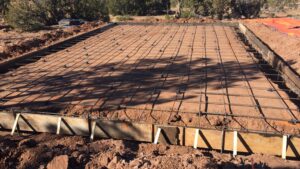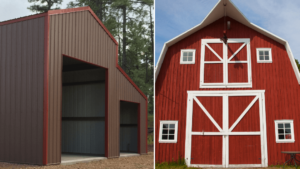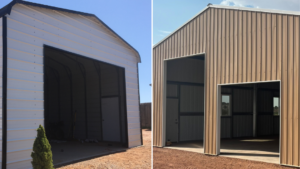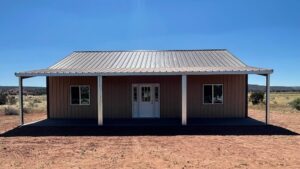When it comes to building a durable and cost-effective structure, your choice of foundation can make or break the project, literally and financially. As a licensed contractor and metal building dealer, we’ve helped hundreds of clients decide between Cold Form vs Red Iron Foundations, and the answer isn’t always as clear-cut as you might think.
Whether you’re a new homebuilder looking for long-term value or an investor focused on ROI, this guide will break down what matters most so you can make an informed decision.
What Are Cold Form and Red Iron Foundations?
Cold Form Foundations (aka Light Gauge Steel)
Cold-formed steel structures are made from thin sheets of steel that are bent into shape without the use of heat (hence “cold” formed). These are lightweight, easier to handle, and often used in residential metal buildings or smaller commercial structures.
Red Iron Foundations (aka I-Beam Steel)
Red iron buildings use heavy, hot-rolled steel I-beams that can support more weight and span wider distances. These buildings are known for their durability and are commonly seen in warehouses, large agricultural buildings, and commercial structures.
When it comes to foundations, your choice between the two affects everything from the engineering load to slab thickness to total cost.
Cost Comparison: Upfront vs Long-Term
Upfront Costs
- Cold Form Foundations tend to be less expensive upfront. Why? The materials are lighter, meaning you spend less on transportation and installation.
- Red Iron Foundations, on the other hand, require heavier equipment and deeper, reinforced concrete piers due to the weight of the steel, driving the price up at the start.
💡 Inside look: We’ve had clients save thousands in upfront costs by going with cold form. The lighter framing allows for a shallower slab and fewer reinforcements. However, this will all depend on what the building will be used for long term. However, red iron supports all the weight put on it and can endure every natural climate.
Long-Term Costs
- Cold Form can sometimes result in higher long-term maintenance if not engineered properly for high-wind or snow-load areas.
- Red Iron, while more expensive to begin with, is extremely low maintenance and offers peace of mind in tough climates.
Structural Strength & Load-Bearing
Cold Form
Cold form works well for buildings under 2,500 sq ft. It offers excellent load-bearing when properly engineered and reinforced, but can flex more under stress, requiring bracing.
Red Iron
Red iron steel is a beast. It can handle massive loads, high winds, and snow loads without breaking a sweat. It’s ideal for industrial, agricultural, and large residential applications.
Speed of Construction
Cold Form Wins in Simplicity
Because the materials are lighter and easier to work with, cold-formed buildings go up faster. For simple projects and small crews, this can be a major benefit.
Red Iron Needs More Muscle
Due to the weight of the steel, red iron buildings require heavy equipment and more manpower. However, the frame often comes pre-welded and bolted, allowing for quick assembly once the groundwork is done.
Foundation Requirements
This is where things get interesting for the Cold Form vs Red Iron Foundations debate.
- Cold Form often allows for a traditional monolithic slab or pier-and-beam system.
- Red Iron generally requires a thicker slab, deeper footings, and rebar-reinforced piers to handle the load.
We recently did a side-by-side build comparison for two identical barn-style homes—one cold-formed and one red iron. The red iron foundation cost about 30% more due to deeper trenching and more concrete, but it also increased the appraised value of the property.
Climate and Environmental Factors
Cold Form
Better suited for dry, mild climates or where budget is the primary concern. It can handle harsh climates if designed and sealed properly, but may require more ongoing attention.
Red Iron
If you’re building in an area prone to high winds, heavy snow, or seismic activity, red iron is a better bet. It’s heavier, sturdier, and more resistant to warping over time.
Resale and Appraisal Value
This might surprise you: appraisers and buyers often place a higher value on red iron buildings due to their commercial-grade materials and perceived durability. If resale is part of your strategy, that matters.
Which One Should You Choose?
Choose Cold Form If:
- You want a faster, cheaper build
- You’re building a small to mid-size structure
- You’re in a mild climate
- DIY installation is a priority
Choose Red Iron If:
- You want maximum durability and longevity
- You’re building a large structure
- You’re in a climate with high wind/snow loads
- You’re thinking long-term resale and ROI
Final Thoughts from the Jobsite
At The Luna Crew, we’ve built both types of foundations across Arizona, and our advice is always the same: start with your goals and budget. If you need a quick workshop or garage, cold form might be perfect. If you’re building a forever home or a large barn-dominium, red iron might be worth the initial investment.
And always work with an experienced contractor who understands the unique challenges of each system, especially when it comes to Cold Form vs Red Iron Foundations. Getting the foundation right means fewer headaches (and dollars) down the road. Reach out to us and let us know what you are looking to build so we can get you the right building and foundation! We’re happy to help!
References
- American Institute of Steel Construction. “Designing Cold-Formed vs Hot-Rolled Steel.” www.aisc.org
- Metal Building Manufacturers Association. “Best Practices for Foundation Design.” www.mbma.com





